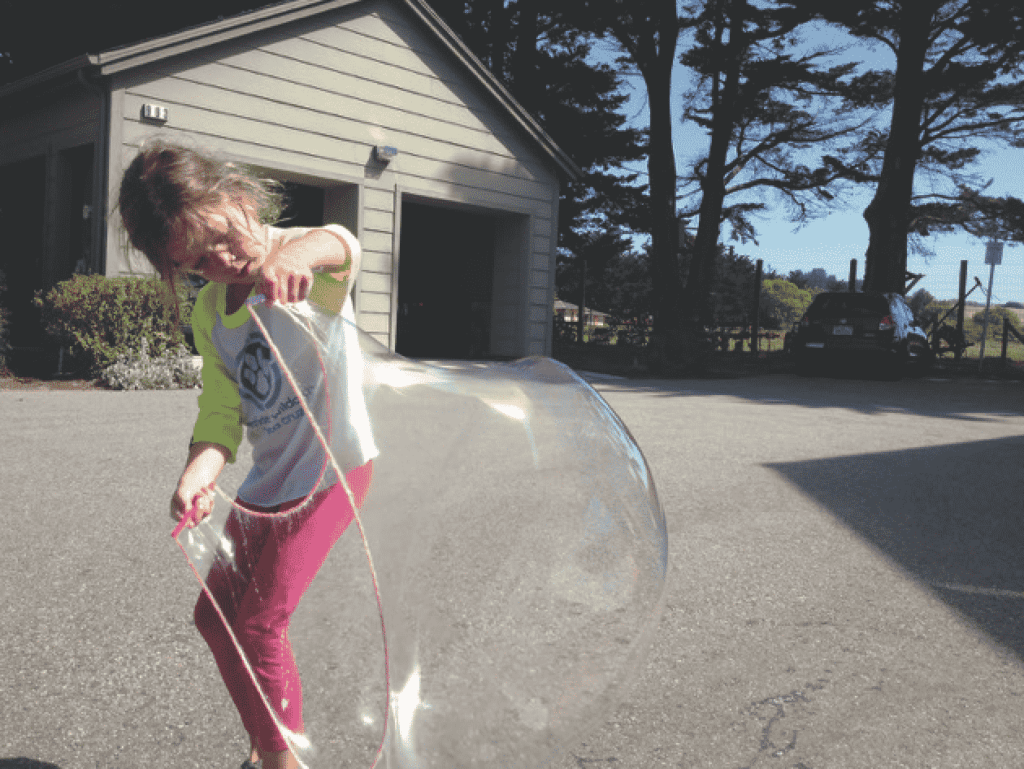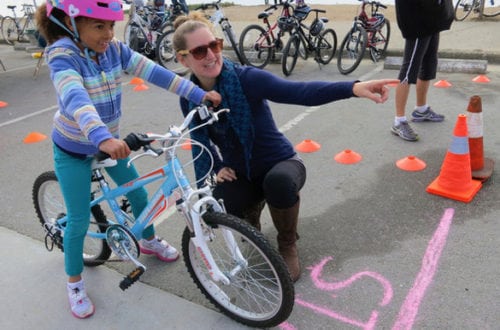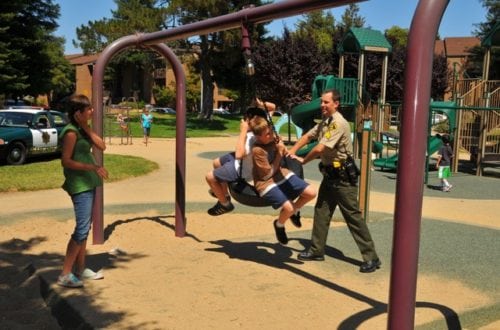It Isn’t Summer Without Plenty of Bubbles
Here’s How to Make Your Own
By Jennifer K Mahal
Santa Cruz Children’s Museum of Discovery

Summer is here, with its warm, sunny days. It’s a great time to be outdoors. One thing we love to do outside is blow gigantic soap bubbles! It’s fun, if a bit messy.
Bubbles are basically a very thin film of soapy water filled with a gas, in most cases air. If you looked at their molecules (the incredibly tiny building blocks that make up matter), you would see a layer of water molecules sandwiched between two layers of soap molecules. The layers creating the bubble walls are only millionths of an inch thick!
A plain glass of water won’t form bubbles because of surface tension. The molecules of water at the top of the glass are more attracted to the molecules of water beneath them than the air above it. That strong attraction creates a high surface tension. When you add soap to the water, it lowers the attraction between the water molecules, letting us make bubbles.
Simply adding soap to water will let you make small bubbles. But how do you make giant ones? You add ingredients that slow down the rate at which the water in the bubble evaporates. Why? Because bubbles burst when the molecules of water in between the molecular layers of soap disappear.
The cornstarch and glycerine in the recipe below make bubbles stronger by keeping the H2O layer in the bubble from disappearing quite so fast. H2O is the molecular formula for water, which has two hydrogen atoms bonded to an oxygen atom.
You may notice shimmery colors on the surface of your bubble. When we see rainbows in the sky, it’s because white light is passing by through water, which acts like a prism, bending the light so we can see the colors. That is NOT what happens when you look at a bubble!
Instead, when a light wave hits a bubble, some of the light wave reflects from the outer surface of the bubble and some reflects from the inner surface. Both travel to the eye and interfere with each other, making some colors brighter and removing others. The colors that are left are known as “interference colors.” What you see when you look at each bubble depends on the thickness of the water and soap!
For the Giant Bubble Mix (adapted from the Happy Hooligans web site), you will need:
* 6 cups of water
* ½ cup dish detergent (Dawn is recommended, but we used Method and it worked fine)
* ½ cup cornstarch
* 1 tablespoon baking powder (NOT SODA)
* 1 tablespoon glycerine (Can be found at the drugstore)

In a bucket, dissolve the cornstarch into the water. Mix well. Gently stir in the other ingredients without creating bubbles. Making it frothy at this point will not help. Let the mix sit for at least an hour before you use it. Doing so will help the soap and water work out their molecular attractions to result in stronger bubbles.
You can make a simple bubble wand using two straws and yarn. Cut a piece of yarn that is 6 times the size of the straw. Then thread it through both straws, tying a knot to form a loop. Using the straws as handles, dip the yarn into the mix, pulling the straws apart to make the bubble film appear. Move it or blow to create bubbles. Have fun!
Discover more science and art at the Santa Cruz Children’s Museum of Discovery in the Capitola Mall. Learn more at www.sccmod.org.
Jennifer K Mahal is the Santa Cruz Children’s Museum of Discovery’s volunteer director of public relations and marketing. She lives in Santa Cruz with her husband and two children.
You May Also Like

At Cabrillo, Special Needs Become Assets
May 28, 2018
It’s a No-Brainerz: Wear a Helmet – Six Tips for Bike Helmet Safety
May 27, 2018

